Denis Leary - Mary Brien
Hubert Ferns mother Johanna was born in Melbourne to Irish parents Denis and Mary Leary (born Brien). This discussion is about Denis and Mary's Irish background and migration to Australia.
O'Leary and O'Brien Names
'O’Leary is an anglicized form of the old Gaelic word O’Laoghaire which translates literally as “keeper of the calves.” Laoghaire was the name borne by a 5th century king of Ireland who reigned at the time of St. Patrick. It is from him that the O’Leary sept claims descent. O’Leary and Leary are the two most common spellings today. O’Leary is mainly found in Ireland, Leary outside.'
[Select Surnames Site]
'The early history of the O’Brien clan is as a Dalcassian tribe in SW Ireland and then with Brian Boru, the legendary king of Ireland who defeated the Norsemen at Clondorf in 1014 but died in the process. The Ui Braians ruled over Munster after Brian Boru’s death and, as O’Briens, emerged as one of the chief dynastic families of Ireland.'
[Select Surnames Site] [Wikipedia-Dalcassians]
As discussed in 'Celtic Naming Patterns', there was some flexibility about the use of a preceding 'O' in names, so the spelling given in the various records is used in Ferns Roots.
Leary and Brien Family Origins
Denis (31) and Mary (27) Leary (married) migrated to Australia in 1839 aboard the ship William Metcalfe. The shipping passenger records show they came from County Tipperary. Also on their vessel were William and Ellen Bryan (married) from South Tipperary and Margaret O'Brien aged 23 (unmarried) of Tipperary. Their voyage looked like this:
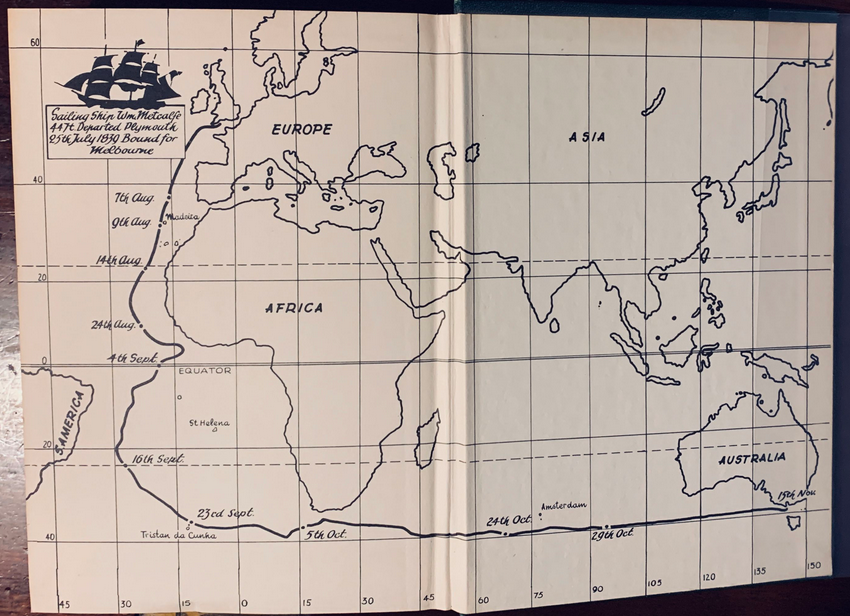
William Metcalfe voyage of 1839 - Plymouth - Melbourne
At the conclusion of their voyage Denis and Mary plus Margaret Brien were engaged as a group to provide servant duties to a doctor. Margaret' O'Brien's name was now recorded with no 'O', so is either a clerical issue or an indication of the flexibility given by people in the pronunciation or spelling of their names.
Families on the same ship?
Winsom Lilley, daughter of Hubert's sister Kit, wrote in a letter that 'Mary's family also came from Birr, Ireland and my mother (Kit) says the two families came out on the same ship.'
Let's first look for families 'on the same ship'.
On the William Metcalfe with Denis and Mary was Margaret Brien/O'Brien. Given that she left the ship as a part of a threesome for their employment, it is likely that Mary and Margaret were sisters or cousins. However, fellow passengers William and Ellen Bryan (of South Tipperary) are probably less directly related - possibly with an earlier clan or sept connection. In support of this, some shipping records show that other Catholic 'Bryan' families give their origin as 'Clonmel' which is a town in South Tipperary on the border with County Waterford. So while there could still be name-spelling issues, my thoughts are that one sister/cousin traveling on the same boat is hardly likely to be termed a 'family'.
Considering the Ferns family, Bernard and Catherine Ferns migrated to Melbourne fifteen years later with six children in 1854 aboard the Matoaka. Was anyone else of interest aboard their vessel? Well 'Bingo!' There were five Brien, two O'Brien and three Bryan passengers also traveling on that ship. If we discount the Bryan group, and one O'Brien who was Church of England, the five Brien and one O'Brien passengers were all Catholic and from County Tipperary. This has definite potential to be a family group related to Mary Leary (Brien) and is worthy of further research. I think we give Winsom and Kit a tick for their 'families came out on the same ship' proposal.
Mary's family from Birr?
Let's see if we can make sense of 'Mary's family also came from Birr.' So the issue is that Birr is in County Offaly (Kings County) and the Brien group are all from County Tipperary. Lets look at a map of Irish counties. On the map below, County Tipperary is marked in green as a part of the Province of Munster and has an adjoining border with Offaly (coloured yellow) to the north.
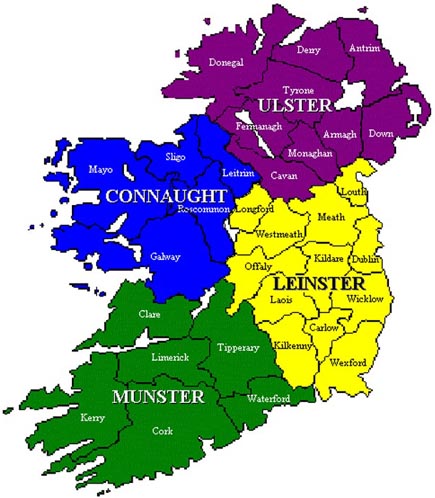
Looking closer at the Tipperary/Offaly border we see that Birr is right on the border of the counties as shown by the dotted County line in the next image.
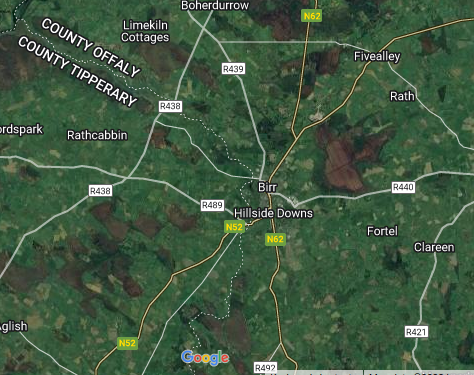
Birr was a relatively large town compared with the surrounding villages, including those across the county line in Tipperary. It would have been perfectly reasonable for someone working and living in northern Tipperary to consider Birr in County Offaly as their main town and shopping center.
But wait, there's more! In Birr, St. Brendan's Church is the central church in the Catholic parish of 'Birr and Loughkeen'. Here is another map showing the outline of that Parish:
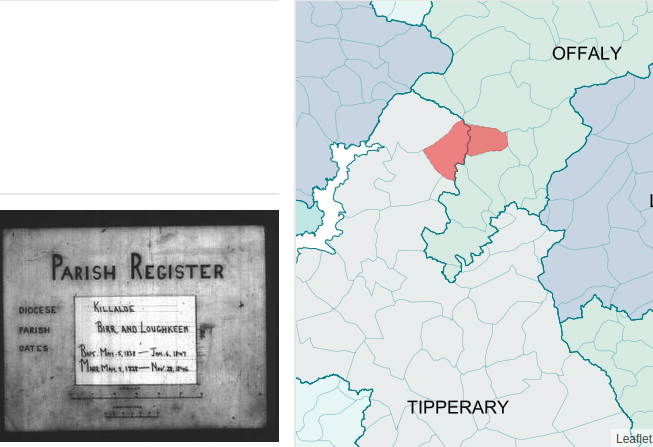
The Parish of St Brendan's Church spreads across the county line serving a flock living in both northern Tipperary and Offaly. Again, further research would clarify exactly what the connections are, but I think it is fair to say Mary and family could easily have lived in Tipperary and considered Birr in Offaly as their home town. Well done Winsom and Kit.
A closer connection?
I think there is an interesting aspect about the two family groups who were on the Matoaka. Let's recall who was aboard:
Ferns: Bernard (38), Catherine (35), Ellen (18), Eliza (16), Catherine (15), John (13), Mary (10), William (8); and
Brien: Nancy (22), Catherine (20), Elizabeth (18), Edmond (16), Mary (14), plus Margaret O'Brien (20).
My thought is that the Brien group are all very young to be traveling to the other side of the world alone. I think that Bernard and Catherine Ferns may have provided a sort of 'guardianship' role for the Brien's, making this a pre-planned, very tight family group and not just coincidental travelers on the same vessel.
The Voyage Out
So where did the William Metcalfe map of Denis and Mary's 1839 voyage come from? We have another passenger to thank for that. Mr Jonathan Were and family traveled out to Australia on the same ship, with Mr Were keeping a diary of their voyage and his early days in Melbourne. Publishing of that diary has made available one of the few first-hand and detailed records of the pioneers to Melbourne in its earliest days.
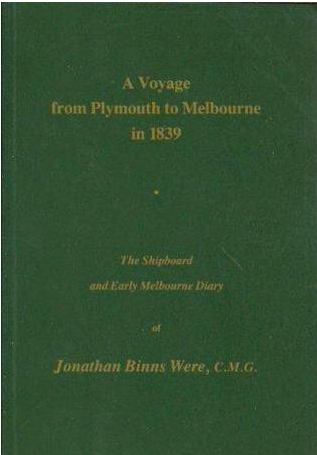
Mr Were and family paid their own way and lived in the upper cabins, so saw a different aspect of the journey. However, everybody experienced the rigors of a large group, traveling in a small space, putting up with each other for over three months. The sadness and unease of leaving home for an uncertain future, a rolling boat and upset stomachs, cold weather and storms in the north and south, hot weather and mill-pond weeks of calm in the doldrums. Excitement was experienced at sighting other vessels, first views of whales, dolphins and flying fish, of phosphorescence around the ship at night and of the first views of the Australian shoreline as they approached their destination.
The William Metcalfe had approached the entrance to Port Philip Bay at dusk so the Captain held the boat out to sea overnight. In the morning they came in through the heads uneventfully and were then presented with the great expanse of water within the bay. Sailing the last 35 miles brought them to the promontory containing Williams Town at the mouth of the 'Yarra Yarra' river. When they rounded the promontory into Hobsons Bay their view opened up to show an unexpected fleet of vessels (three ships, eight barques, five brigs and two schooners) all delivering goods and passengers for Melbourne - which was still eight miles around the bay by track and road.
Their ship had departed Plymouth on 25 July and they had landed in Port Phillip Bay on 15 November 1839 after 115 days and a voyage of over 13,000 miles. The infant Port Philip Settlement of around 3,000 people lived in almost primitive conditions in a township comprising a ragged collection of shops and homes - but which was to become the future great metropolis of Melbourne city. Of the 264 people on their ship 26 were crew and the rest were immigrants, so their arrival would have had a big impact on the town. Of these people, 196 were bounty passengers, which meant their passage was financed by land sales in Australia, the aim being to gain workers to aid in developing this new colony.
Denis and Mary Leary's next phase of life in Australia is recorded in the Australian section.
